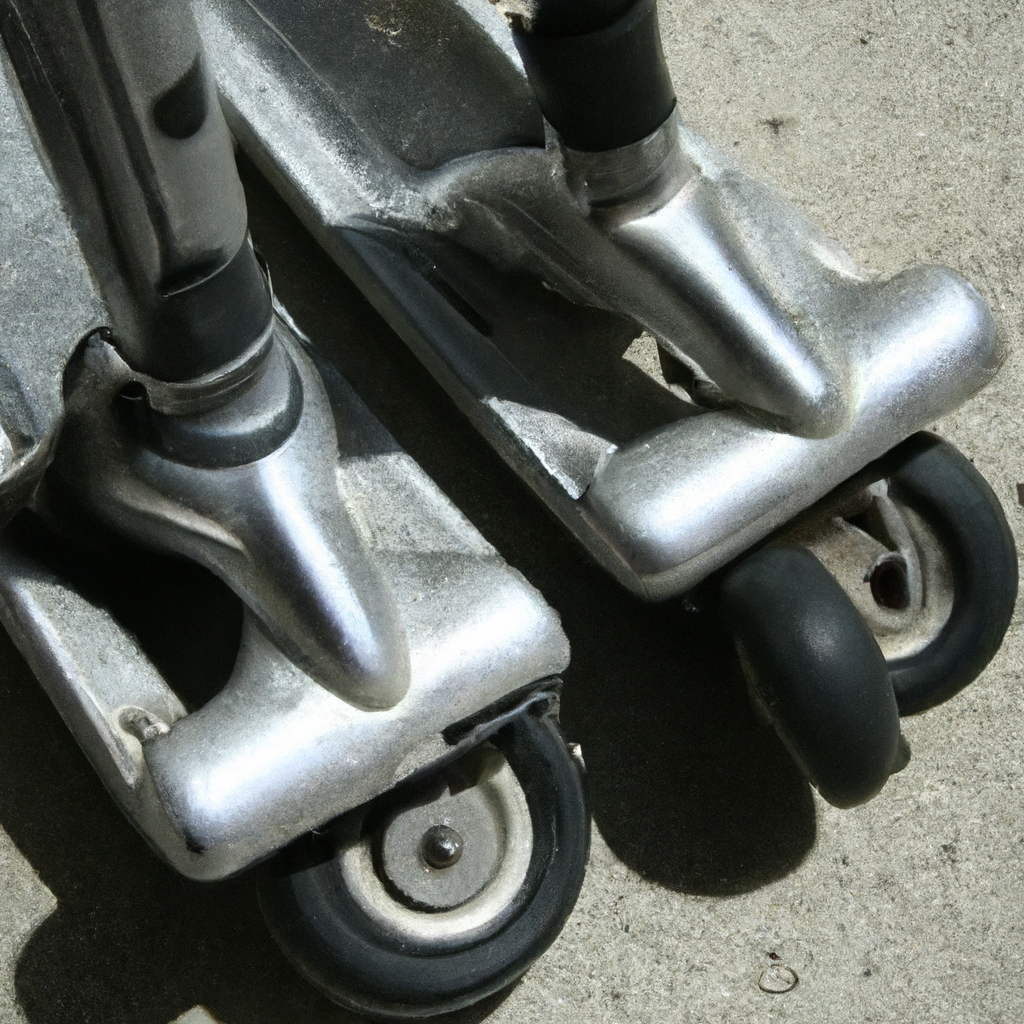Have you ever wondered if electric scooters have pedals like their traditional counterparts? You might be surprised to learn that electric scooters do not have pedals like traditional scooters. While both types of scooters serve as efficient modes of transportation, electric scooters rely on a battery-powered motor to generate their movement, eliminating the need for pedals. This article will explore the key differences between electric and traditional scooters, shedding light on the unique features that make each type of scooter distinct and popular among different groups of riders. So, if you’re curious about the inner workings of electric scooters and how they compare to traditional scooters, read on to uncover the subtle yet fascinating details.
Electric Scooters vs Traditional Scooters
Electric scooters and traditional scooters are two popular modes of transportation that serve different purposes and have distinct features. While both types of scooters provide convenience and efficiency, they differ in several key aspects. In this article, we will delve into the definitions of electric scooters and traditional scooters, explore the components of an electric scooter, discuss the presence or absence of pedals in each type, examine the efficiency and performance of electric scooters compared to traditional scooters, consider safety considerations, delve into the legal regulations surrounding these vehicles, highlight some popular electric scooter brands, and conclude with a summary of the main points discussed.
Definition of Electric Scooters
Electric scooters, also known as e-scooters, are mobility devices that are powered by an electric motor. These compact vehicles have gained immense popularity in recent years due to the growing emphasis on eco-friendly transportation options. Electric scooters are designed to be lightweight and easy to maneuver, making them ideal for short commutes or recreational purposes. They typically feature a scooter frame, handlebars, and a base platform for the rider to stand on.

Definition of Traditional Scooters
On the other hand, traditional scooters are non-electric vehicles that rely on manual propulsion. They are often powered by the rider pushing off the ground with their feet and utilizing pedals to maintain momentum. These scooters have been around for decades and come in various designs and sizes. Traditional scooters are usually made of metal or other sturdy materials and are equipped with handlebars, a single or double deck, and two or three wheels.
Key Differences between Electric Scooters and Traditional Scooters
The most fundamental difference between electric scooters and traditional scooters lies in their propulsion systems. Electric scooters are propelled by an electric motor, whereas traditional scooters rely on human power. This distinction has several implications for the design, functionality, and performance of the two types of scooters.

Components of an Electric Scooter
To understand the key differences between electric scooters and traditional scooters, it is essential to examine the components that make up an electric scooter. While the specific features may vary across different models and brands, the following components are typically found in most electric scooters:
Electric Motor
The electric motor is the heart of an electric scooter. It provides the power necessary for the scooter to move forward. Electric motors come in various sizes and power ratings, with higher wattage motors offering greater speed and acceleration.
Battery
Electric scooters are powered by rechargeable batteries, which store the electrical energy required to run the motor. The battery capacity determines the range of the scooter, indicating how far it can travel on a single charge. Lithium-ion batteries are commonly used in electric scooters due to their high energy density and longer lifespan.
Charging System
To replenish the battery, electric scooters are equipped with a charging system. This typically involves a charging port, which allows the user to connect the scooter to an electrical outlet. Some advanced electric scooters may also feature regenerative braking, where the kinetic energy generated during braking is converted into electrical energy and fed back into the battery.
Control Panel
The control panel on an electric scooter provides the rider with a user interface to monitor and adjust various settings. It usually includes a display for battery level, speedometer, and other relevant information. The control panel may also incorporate buttons or switches to control the scooter’s lighting, horn, and other features.
Brakes
To ensure safe operation and control, electric scooters are equipped with braking systems. This typically includes mechanical or electronic brakes, such as disc brakes or drum brakes. The braking system is essential for allowing the rider to quickly stop or slow down when needed.
Tires
Electric scooters feature specially designed tires that provide optimal grip and stability on various surfaces. These tires are typically made of rubber and can vary in size and tread pattern depending on the scooter’s intended use. Some electric scooters may feature air-filled tires for enhanced shock absorption.
Frame
The frame of an electric scooter provides structural support and determines its overall durability and stability. Electric scooter frames are usually made of lightweight yet sturdy materials such as aluminum or steel. The frame design also affects the scooter’s weight and maneuverability.
By understanding the various components of an electric scooter, we can better appreciate the unique features and advantages it offers compared to traditional scooters.
Pedals in Traditional Scooters
Unlike electric scooters, traditional scooters incorporate pedals into their design, allowing the rider to manually propel the vehicle forward. Pedals have been an integral part of traditional scooters for decades, and they serve several important purposes.
Purpose of Pedals
The primary purpose of pedals in traditional scooters is to provide a means for the rider to generate forward momentum and assist in maneuvering the scooter. By pushing off the ground with their feet and using the pedals, riders can control the speed and direction of the scooter more effectively.
Manual Propulsion
Pedals enable manual propulsion in traditional scooters by converting human effort into kinetic energy. By repeatedly pushing the pedals with their feet, riders can maintain a steady pace without relying solely on gravity or external sources of power.
Mechanism and Design
Pedals are typically attached to a rod or axle that connects to the scooter’s rear wheel(s). As the rider pushes down on the pedals, they rotate the axle, causing the wheels to turn. This turning motion propels the scooter forward, mimicking the action of a bicycle or similar human-powered vehicles.
Common Features
Pedals in traditional scooters are usually centrally positioned on the deck, allowing the rider to comfortably position their feet and apply force to move the scooter forward. They are often made of durable materials such as metal or plastic and designed to withstand regular use and various weather conditions.

No Pedals in Electric Scooters
In contrast to traditional scooters, electric scooters do not incorporate pedals into their design. Instead, they rely solely on the power generated by the electric motor. This omission of pedals in electric scooters has its own set of implications and advantages.
Electric Motor Propulsion
The absence of pedals means that electric scooters rely entirely on the power generated by the electric motor for propulsion. This motor, fueled by the energy stored in the battery, provides consistent and efficient propulsion, allowing the rider to enjoy a smooth and effortless ride.
Reasons for Omitting Pedals
The decision to omit pedals in electric scooters is primarily driven by the desire to simplify and streamline the riding experience. Electric scooters are designed to offer a convenient and hassle-free mode of transportation, and the inclusion of pedals would introduce an element of manual effort that contradicts this objective. By removing the need for physical exertion, electric scooters cater to a broader audience, including those who may have physical limitations or simply prefer a more effortless mode of transportation.
Advantages of Not Having Pedals
The absence of pedals in electric scooters offers several advantages over traditional scooters. Firstly, it eliminates the need for the rider to continually push off the ground and pedal to maintain momentum. This allows for a more relaxed and comfortable riding experience, especially during longer journeys. Additionally, not having pedals reduces the overall weight and complexity of the scooter, making it more portable and easier to store or transport when not in use.
Footrests in Electric Scooters
While electric scooters may lack pedals, they often feature footrests as a substitute. Footrests serve a similar purpose to pedals, providing a place for the rider to position their feet comfortably. Let’s explore the characteristics and benefits of footrests in electric scooters.
Substitute for Pedals
Footrests in electric scooters serve as a substitute for pedals by providing a stable and comfortable platform for the rider’s feet. While they do not contribute directly to the propulsion of the scooter, footrests play a crucial role in maintaining rider balance and control.
Location and Design
Footrests in electric scooters are usually positioned on the deck, within easy reach of the rider’s feet. They are typically flat and spacious, allowing riders to adjust their foot position as needed for optimal comfort. Some electric scooters may feature foldable footrests, enabling compact storage or accommodating riders of different heights.
Benefits of Footrests
The incorporation of footrests in electric scooters offers several benefits. Firstly, footrests provide a stable and secure surface for the rider’s feet, reducing the risk of slippage or accidents while riding. They also allow riders to shift their weight and stance, enhancing overall balance and control. Furthermore, footrests offer a convenient spot for the rider to rest their feet during stops or while waiting at traffic lights, ensuring maximum comfort during the journey.

Efficiency and Performance
Efficiency and performance are crucial considerations when comparing electric scooters and traditional scooters. Although both types of scooters serve as efficient and economical means of transportation, the presence of an electric motor in electric scooters introduces a range of factors that differentiate their performance from traditional scooters.
Motor Efficiency
One of the key advantages of electric scooters is their exceptional motor efficiency. Electric motors are known for their high energy conversion rates, meaning they can convert more electrical energy into mechanical energy with minimal waste. This efficiency translates into longer battery life and increased range, enabling riders to travel greater distances on a single charge compared to traditional scooters.
Speed and Acceleration
Electric scooters, powered by electric motors, typically offer quicker acceleration and higher top speeds compared to traditional scooters. The instant torque provided by electric motors allows electric scooters to reach their maximum speed rapidly, making them ideal for short-distance commuting or zipping through congested city streets.
Power-to-Weight Ratio
Electric scooters often boast a favorable power-to-weight ratio, thanks to their lightweight design and potent electric motors. The combination of a lightweight frame and a powerful motor allows electric scooters to achieve impressive acceleration and performance. Traditional scooters, on the other hand, rely on the rider’s physical strength to generate forward momentum, which can result in slower acceleration and overall performance.
Impact on Battery Life
The performance of electric scooters can have a direct impact on battery life. Aggressive acceleration and high speeds place greater strain on the battery, resulting in quicker battery depletion. Riding in eco or energy-saving modes can help conserve battery life and extend the scooter’s range. In contrast, traditional scooters’ performance is less influenced by the battery life since they rely on the rider’s physical effort.
Comparison with Traditional Scooters
When comparing the efficiency and performance of electric scooters and traditional scooters, it is important to note that each type caters to different needs and preferences. Traditional scooters, with their reliance on human propulsion, offer a more active and engaging riding experience that may be preferred by some riders. In contrast, electric scooters provide a more effortless and convenient mode of transportation, appealing to riders seeking a quieter, eco-friendly, and low-maintenance option.
Safety Considerations
Safety is of utmost importance when it comes to choosing a scooter, regardless of whether it is electric or traditional. Both types of scooters present their own set of safety considerations, and riders must be aware of these factors to ensure a safe and enjoyable riding experience.
Stability and Control
Electric scooters and traditional scooters differ in their stability and control characteristics. Electric scooters often feature a lower center of gravity due to the placement of the battery and motor, which enhances stability and maneuverability. Traditional scooters, on the other hand, rely on the rider’s balance and physical input to maintain stability and control.
Handling and Maneuverability
Electric scooters are known for their nimble and responsive handling, making them well-suited for navigating through tight spaces and congested areas. The absence of pedals allows riders to focus solely on steering and speed control. Traditional scooters require the rider to coordinate their balance, pedaling, and steering, which can influence handling and maneuverability to some extent.
Braking System
Both electric scooters and traditional scooters are equipped with braking systems to ensure safe stopping. However, the specific braking mechanisms may vary. Electric scooters commonly feature electronic or mechanical brakes, such as disc brakes or drum brakes. Traditional scooters typically use friction-based braking systems, where the rider needs to push their foot against the ground or apply pressure to the brakes positioned on the handlebars. It is crucial for riders of both types of scooters to familiarize themselves with the functioning of the braking system and practice proper braking techniques to ensure effective and timely stops.
Risk of Pedal Striking Ground
Traditional scooters that incorporate pedals pose a potential risk of pedal strike, particularly when maneuvering around corners or uneven terrain. Pedal strike occurs when the pedals come into contact with the ground, resulting in loss of balance and potential accidents. This risk is eliminated in electric scooters, as they lack pedals altogether.
Comparison with Traditional Scooters
When considering safety, it is important to recognize that both electric scooters and traditional scooters have their inherent risks, and the level of safety is influenced by various factors, including rider behavior, road conditions, and adherence to traffic rules and regulations. Riders must exercise caution, wear appropriate safety gear such as helmets and knee pads, and follow the recommended guidelines to ensure a safe riding experience, regardless of the type of scooter they choose.

Legal Regulations
Legal regulations governing the use of electric scooters and traditional scooters vary across regions and countries. It is important for riders to familiarize themselves with the applicable rules and regulations to avoid legal complications and ensure responsible and lawful riding. Key factors to consider include:
Licensing and Age Restrictions
Many jurisdictions have specific age restrictions for operating electric scooters and traditional scooters. In some places, a minimum age requirement may exist, while others may mandate a valid driver’s license. It is crucial for riders to understand and comply with these licensing and age restrictions to avoid penalties and ensure safe riding.
Registration and Insurance
In certain areas, electric scooters may need to be registered and insured, similar to other motorized vehicles. This requirement aims to ensure accountability and protection for both riders and pedestrians. Traditional scooters typically do not require registration or insurance as they are manually propelled and fall within the jurisdiction of non-motorized vehicles. However, it is always advisable to consult local authorities or transportation departments to confirm the specific legal requirements.
Road Use Regulations
Electric scooters, like traditional scooters, must adhere to road use regulations to maintain safety and order on public roads. These regulations may include restrictions on speed, designated scooter lanes, and requirements for signaling and lights. It is the responsibility of each rider to understand and comply with the road use regulations to ensure personal safety and contribute to a harmonious relationship with other road users.
Specific Rules for Different Locations
Regulations and guidelines related to electric scooters and traditional scooters can vary significantly from one location to another. Some areas may have designated areas or routes for scooters, while others may outright ban them from certain roads or public spaces. It is essential for riders to research and familiarize themselves with the specific rules and guidelines applicable in their own area of use.
Popular Electric Scooter Brands
Several established brands have emerged as leaders in the electric scooter industry. These brands offer a wide range of electric scooters, each with its own unique features and capabilities. Let’s take a look at some popular electric scooter brands:
Brand A
Brand A is recognized for its cutting-edge technology and innovative designs. Their electric scooters boast powerful motors, long-lasting batteries, and sleek aesthetics.
Brand B
Brand B focuses on providing affordable and practical electric scooters for everyday use. They prioritize user-friendly features, durability, and value for money, making their scooters accessible to a wide range of riders.
Brand C
Brand C specializes in high-performance electric scooters specifically designed for adrenaline junkies and thrill-seekers. They offer advanced suspension systems, high-speed capabilities, and rugged construction for off-road adventures.
Brand D
Brand D is known for its eco-conscious approach, focusing on sustainability and environmentally friendly materials. Their electric scooters are designed with an emphasis on energy efficiency, extended battery life, and recyclability.
Conclusion
As we have explored in this comprehensive article, electric scooters and traditional scooters have distinct characteristics and cater to different preferences and needs. Electric scooters, powered by electric motors and equipped with various components such as batteries and control panels, offer a convenient and eco-friendly mode of transportation. The absence of pedals in electric scooters allows for effortless riding, while footrests provide a stable platform for the rider’s feet. Electric scooters excel in efficiency, performance, and motorized propulsion, offering quick acceleration and high speeds. Safety considerations and legal regulations should always be taken into account to ensure responsible and safe riding. Whether you opt for an electric scooter or a traditional scooter, it is important to choose a reputable brand that aligns with your specific requirements. With the abundance of options available, riders can select an electric scooter that suits their preferences, style, and desired level of performance. Ultimately, the choice between electric scooters and traditional scooters boils down to personal preference, intended use, and the unique benefits each type offers. Embark on your scooter journey with confidence, knowing that you are partaking in an increasingly popular and sustainable mode of transportation. Happy scooting!

